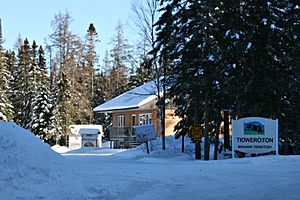Doncaster, Quebec facts for kids
Quick facts for kids
Doncaster
Tioweró:ton
|
|
|---|---|
|
Indian reserve
|
|
 |
|
| Lua error in Module:Location_map at line 416: Malformed coordinates value. | |
| Country | Canada |
| Province | Quebec |
| Region | Laurentides |
| Regional County | n/a |
| Established | August 9, 1853 |
| Government | |
| • Type | Indian Reserve |
| Area | |
| • Total | 78.00 km2 (30.12 sq mi) |
| • Land | 76.13 km2 (29.39 sq mi) |
| Population
(2010)
|
|
| • Total | 4 |
| • Density | 0.05/km2 (0.1/sq mi) |
| Time zone | UTC-5 (EST) |
| • Summer (DST) | UTC-4 (EDT) |
Doncaster (in Mohawk: Tioweró:ton) is a special area of land in Quebec, Canada. It is officially called Doncaster 17. This land is a Native Reserve for the Mohawk First Nation.
It is located in the Laurentides region. The Mohawk people from Kanesatake and Kahnawake reserves use this land. Doncaster is about 30 kilometers east of Mont-Tremblant. It is named after a town in England.
Very few people live here, or sometimes no one at all. The Mohawk people use Doncaster as a place for hunting and fishing.
Contents
Doncaster's History
Setting Aside the Land
In 1851, a law was passed to set aside land in Lower Canada. This land was for the use of the Seven Nations of Canada, who were First Nation tribes. Two years later, on August 9, 1853, the government approved a plan. This plan gave the Mohawk people from Kahnawake and Kanesatake (also called Oka) a specific area.
They received the southeast part of Doncaster township. This area was about 16,000 acres (65 square kilometers).
Land Disputes and Squatters
In the late 1800s, some European-Canadian settlers, called "squatters," moved onto parts of this land. They did not have permission to be there. These squatters often asked the government to open the land for settlement.
On May 26, 1890, 43 squatters signed a petition. They asked the government to get rid of the Mohawk reserve. They claimed the land was good for farming. They also said the Mohawk people would never use it because there wasn't much game for hunting. They even said wood was being stolen from the reserve.
The squatters believed the reserve stopped their community from growing. They hoped the government would agree to their request.
Mohawk Refusal and Government Action
The Mohawk people refused to rent or sell their land. They wanted to keep it for their community. In 1896, a government official wrote about the ongoing problem. He noted that the Mohawk were determined not to give up their land. They felt the squatters should pay rent for using it.
From 1897 to 1905, the squatters kept trying to get official land grants. But the government kept saying that the reserve was for the Mohawk people.
Finally, in 1904, the government stepped in. They paid the squatters for any improvements they had made to the land. In return, the squatters had to promise to leave the reserve forever. They also agreed not to be sued for trespassing (being on the land illegally). This helped to end the dispute.
Sharing the Reserve
In 1905, the government suggested a way to manage Doncaster 17. They proposed that the Kahnawake and Kanesatake bands share the responsibility. The Kahnawake people made up two-thirds of the total population of the two groups. The Kanesatake people made up one-third.
A newspaper reported in 1905 that the Indian agent suggested this arrangement. The Kahnawake people wanted to share the reserve based on population size. The Kanesatake people, who were a smaller group, wanted an equal share.
Eventually, the bands agreed to share the management. Kahnawake would have two-thirds of the financial responsibility, and Kanesatake one-third. This way of sharing was similar to how Mohawk people traditionally managed their shared lands. This arrangement continues to be in place today.
Population Information
Doncaster 17 has a very small population.
- Population in 2006: Not available
- Population in 2001: Not available
- Population in 1996: 0 people
- Population in 1991: 4 people

